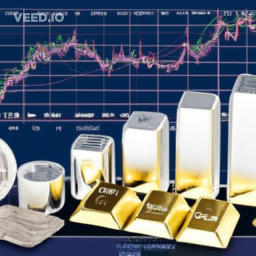Precious metals have long been a cornerstone of wealth preservation and investment diversification. Whether you’re looking to hedge against inflation, secure a tangible asset, or add stability to your investment portfolio, precious metals like gold, silver, platinum, and palladium offer unique advantages. However, navigating the world of precious metal investments requires understanding different investment methods and market dynamics.
In this blog, we’ll explore how to invest in precious metals, including the various options available, the benefits and risks associated with each, and practical tips to help you make informed investment decisions.
1. Understanding Precious Metals as an Investment
Precious metals are natural elements that are valuable due to their rarity, industrial uses, and cultural significance. The most commonly traded precious metals are gold, silver, platinum, and palladium.
- Gold: Known for its role as a hedge against inflation and currency fluctuations, gold is often seen as a safe-haven investment.
- Silver: More affordable than gold, silver has both investment and industrial uses, making it a popular choice for diversifying portfolios.
- Platinum: Rare and used in various industrial applications, platinum offers investment potential along with its unique properties.
- Palladium: Similar to platinum, palladium is used in industrial applications and is considered a valuable investment asset.
2. Investment Options in Precious Metals
There are several ways to invest in precious metals, each with its own set of benefits and considerations.
- Physical Bullion: Buying physical gold, silver, platinum, or palladium in the form of coins, bars, or ingots is a straightforward way to invest. Ensure that you purchase from reputable dealers and consider storage and insurance for your physical assets.
- Pros: Tangible asset, no counterparty risk, potential for significant value appreciation.
- Cons: Requires secure storage, can be less liquid than other investment methods, may involve higher premiums.
- Precious Metal ETFs and Mutual Funds: Exchange-traded funds (ETFs) and mutual funds that invest in precious metals or related mining stocks offer an easy way to gain exposure without holding physical metals.
- Pros: Liquidity, diversification, ease of trading on stock exchanges.
- Cons: Management fees, potential tracking error from physical metal prices, reliance on fund management.
- Mining Stocks: Investing in companies that mine precious metals can provide indirect exposure to the price movements of the metals themselves. This includes purchasing shares of mining companies through stock exchanges.
- Pros: Potential for high returns, dividends from profitable mining companies.
- Cons: Stock price volatility, company-specific risks, less direct exposure to metal prices.
- Futures and Options Contracts: For more advanced investors, futures and options contracts on precious metals provide the opportunity to speculate on price movements or hedge other investments.
- Pros: Potential for high leverage, flexibility in trading strategies.
- Cons: High risk, requires in-depth knowledge, potential for significant losses.
- Precious Metal IRAs: Individual Retirement Accounts (IRAs) can be set up to hold physical precious metals as part of your retirement savings. These accounts must comply with specific IRS rules and regulations.
- Pros: Tax advantages, diversification within retirement accounts.
- Cons: Limited investment options, storage fees, regulatory requirements.
3. Evaluating the Risks and Benefits
Investing in precious metals comes with both potential benefits and risks. Understanding these factors will help you make informed decisions.
- Benefits:
- Diversification: Precious metals often have low correlations with other asset classes, providing diversification benefits.
- Inflation Hedge: Metals like gold have historically preserved value during inflationary periods.
- Tangible Asset: Physical metals offer a tangible store of value and can be a safeguard in times of economic instability.
- Risks:
- Price Volatility: Precious metal prices can be highly volatile, influenced by market trends, geopolitical events, and economic factors.
- Storage and Insurance Costs: Physical metals require secure storage and insurance, adding to the cost of investment.
- Market Speculation: Prices of mining stocks and metal-related ETFs can be affected by market speculation and company-specific issues.
4. Tips for Investing in Precious Metals
To make the most of your precious metal investments, consider the following tips:
- Do Your Research: Understand the market dynamics and factors influencing precious metal prices. Research different investment options and their associated risks and benefits.
- Diversify Your Holdings: Avoid putting all your investment funds into precious metals. Diversify your portfolio with other asset classes to balance risk.
- Stay Informed: Keep up-to-date with market trends, geopolitical developments, and economic indicators that could impact precious metal prices.
- Consult a Financial Advisor: If you’re unsure about how to incorporate precious metals into your investment strategy, seek advice from a financial advisor who specializes in alternative investments.

